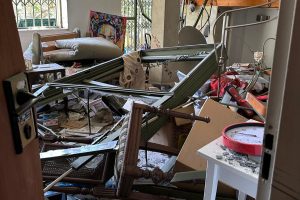Whether it is the intensity of a look, the sparseness of a stage, or the drama of a gesture, Nir Bareket’s photographs don’t just capture the facts of the moment, but they also capture its wonder.
The Market Gallery presents an exhibition entitled Nir Bareket: My Eyes Have Seen. Celebrating 50 years of Photography. The exhibit features photographs from the Bareket collection, the City of Toronto Archives, and the Ontario Jewish Archives Blankenstein Family Heritage Centre (OJA).
The wide-ranging photographs features images from various series: Theatre in Toronto (1976-2003); The Don Jail (1978-1987); The Amsterdam Calendar (1978); The Toronto Calendar (1981); The Homeless in Toronto (1982-2004); and The March of the Living (1994).
“What I find amazing is not just the individual photos, but the breadth of the portfolio. For five decades, Bareket has been photographing theatre in New York City, in Jerusalem and in Toronto, capturing moment after moment. The photographs provide evidence that these plays existed, that they happened at all, keeping for posterity the magic of theatre,” said Michael Wallace, executive director, Theatre Museum Canada.
Bareket was commissioned in 1994 by March of the Living to document the trip. These photographs, now part of the collection of the OJA, include images of participants visiting Jewish cemeteries, the Jewish ghetto in Krakow, and the concentration camps in Poland.
“In Bareket’s photographs, one feels the bleak coldness of the landscape. The horror and despair that occurred there is visceral, and is evident in these haunting photographs,” says Dara Solomon, director of the OJA.
“And yet, the faces of the students, though filled with anguish, provide a light – a youthful warmth – hope. The brilliance in Bareket’s approach is his ability to maintain both the invisibility of a journalist and the eye of the artist – capturing the beauty of these grief-filled moments,.”
The Amsterdam Calendar series comes from Bareket’s 1976-78 stay in the Dutch city representing Toronto in the Toronto Amsterdam Artist Exchange Program. Bareket created a portfolio of photographs based on the concept of the calendar. He photographed individual numbers from one to 31 to represent the days of the month. These numbers appeared on walls, doorways, signs, essentially anywhere that people lived and worked in Amsterdam.
“Almost 35 years later, the archives acquired another calendar portfolio created by Nir Bareket, but in this case, the subject is Toronto, Bareket’s home,” said Michele Dale, City of Toronto Archives.
Bareket shot The Toronto Calendar series in 1981.
“Toronto is my city, and I like to think I know parts of it very well,” said Bareket.
The photographs of The Don Jail series became the first acquisition by the archives of the City of Toronto of work by a contemporary, living photographer.
“Nir Bareket’s photos catch the essence of the mood of the jail: sombre, severe, inhuman, without a soft edge. I was astounded when Nir first showed me his photos. They glowed with the jails’ powerful truth. Bareket’s photo of the jail’s main entrance hangs in my home. I contemplate it daily,” said John Sewell, former Mayor of Toronto.
Following studies at The New York Institute of Photography and the School of Visual Arts in New York City, Bareket worked as a commercial photographer in New York City, in Geneva, Switzerland, and spent three years as chief photographer for The Israel Museum in Jerusalem. Bareket settled in Toronto in 1975.
Bareket has had numerous solo exhibitions dating from 1966 to the present day, including public galleries in New York City, Israel, Stanford University and Toronto. Major public collections in the United States, Holland, Israel, and Canada include Bareket’s photographs.
More recently, Bareket has been focusing on social commentary – an attempt to capture elements of society most people tend to ignore. Bareket dares us to look.
“During the last couple of decades, searching for meaning became my main focus. Now, after my first 50 years as a photographer, the search continues. Photography is not a sprint, it is a marathon,” said Bareket.
Nir Bareket: My Eyes Have Seen will be on display until July 19 at the St. Lawrence Market, 95 Front St. E. There is no admission fee.






